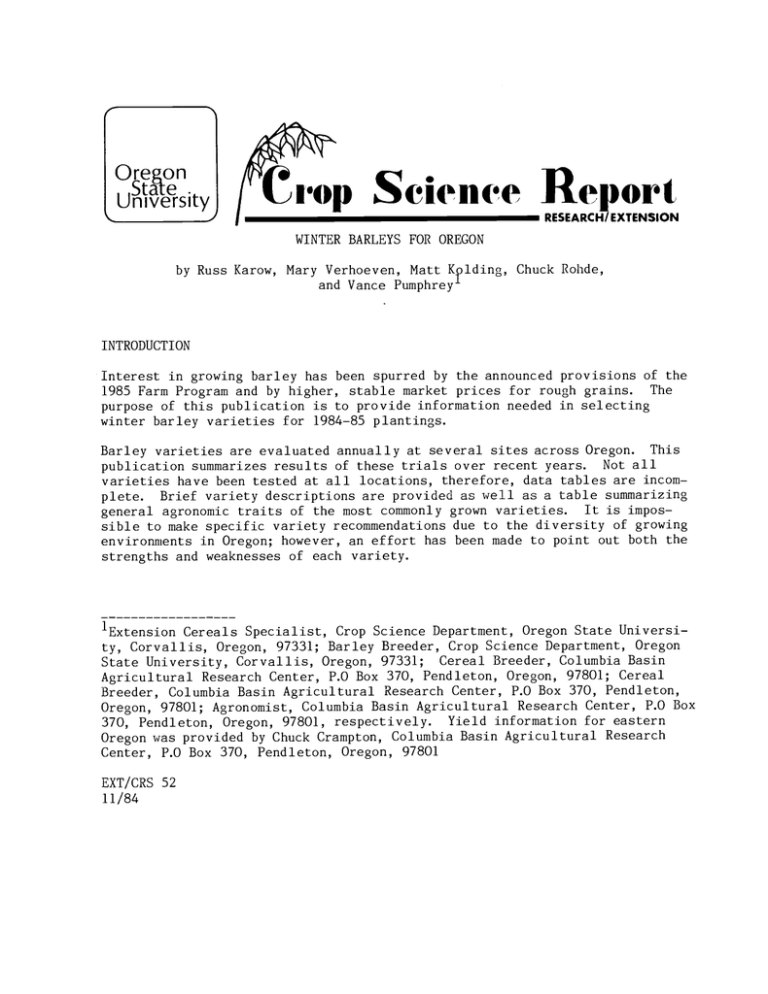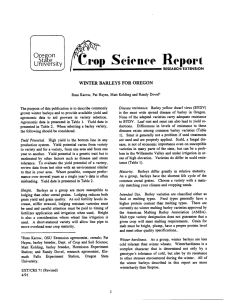Science Report bop Oregon University
advertisement

Oregon State University . bop Science Report RESEARCH/ EXTENSION WINTER BARLEYS FOR OREGON by Russ Karow, Mary Verhoeven, Matt Kplding, Chuck Rohde, and Vance Pumphreyi INTRODUCTION Interest in growing barley has been spurred by the announced provisions of the The 1985 Farm Program and by higher, stable market prices for rough grains. purpose of this publication is to provide information needed in selecting winter barley varieties for 1984-85 plantings. Barley varieties are evaluated annually at several sites across Oregon. This publication summarizes results of these trials over recent years. Not all varieties have been tested at all locations, therefore, data tables are incomBrief variety descriptions are provided as well as a table summarizing plete. general agronomic traits of the most commonly grown varieties. It is impossible to make specific variety recommendations due to the diversity of growing environments in Oregon; however, an effort has been made to point out both the strengths and weaknesses of each variety. 1 Extension Cereals Specialist, Crop Science Department, Oregon State University, Corvallis, Oregon, 97331; Barley Breeder, Crop Science Department, Oregon State University, Corvallis, Oregon, 97331; Cereal Breeder, Columbia Basin Agricultural Research Center, P.0 Box 370, Pendleton, Oregon, 97801; Cereal Breeder, Columbia Basin Agricultural Research Center, P.0 Box 370, Pendleton, Oregon, 97801; Agronomist, Columbia Basin Agricultural Research Center, P.0 Box Yield information for eastern 370, Pendleton, Oregon, 97801, respectively. Oregon was provided by Chuck Crampton, Columbia Basin Agricultural Research Center, P.0 Box 370, Pendleton, Oregon, 97801 EXT/CRS 52 11/84 -2- When selecting a variety, the following should be considered. 1. Height. Barleys as a group are more susceptible to lodging than other cereal grains. As soil fertility levels increase, stiffer strawed, lodging resistant varieties must be used. Lodging reduces both grain yield and grain quality. Height is also a consideration where wheel line irrigation is used. A short-statured variety will allow line pipe to move overhead even at crop maturity. 2. Disease resistance. Barley yellow dwarf virus is the most wide spread disease of barley in Oregon. None of the adapted varieties carry resistance to BYDV. Leaf rust and smut can also lead to yield reductions. Differences in levels of resistance to these diseases exists among common barley varieties (Table 1). Smut is generally not a problem if seed treatments are used and are properly applied. Scald, a fungal disease, is of no economic importance even on susceptible varieties in many parts of the state but can be a problem in the Willamette Valley and under irrigation in areas of high elevation. 3. Maturity. Barleys differ greatly in relative maturity. As a group, barleys have the shortest life cycle of the common cereal grains. Choose a variety with a maturity matching your climate and cropping needs. 4. Intended Use. Barley varieties are classified either as feed or malting types. Feed types generally have a higher protein content than malting types. Malt type variety designation does not guarantee that a given crop will meet malting requirements. Grain for malt must be bright, plump, and have a proper protein level. Malt grade barleys are difficult to grow consistently in most Oregon environments. VARIETIES Boyer Boyer is a medium height, mid-season, feed grain variety released by Washington State University (WSU) in 1975. Grain test weight is adequate. Boyer is resistant to lodging and has good winterhardiness. The spike is middense and kernels are white. Boyer is best adapted to high yielding environments. Hesk Hesk is a medium height, medium to mid-late, shatter resistant feed barley released in 1980 by Oregon State University (OSU). It is resistant to lodging and has adequate test weight. Hesk is well-adapted for growing in the higher yielding areas of eastern Oregon, averaging 5 percent higher yield than Boyer. Hudson Hudson is a medium tall, early maturing feed grain variety released by Cornell University, New York, in 1951. Grain test weights are heavy. Plants -3- are winterhardy, but are moderately susceptible to lodging. The spike is dense and short and kernels are white or occasionally light blue. Kamiak Kamiak is a medium tall, early maturing, feed grain variety released by WSU in 1971. It has good test weight, average lodging resistance, and adequate winterhardiness. Kamiak spikes are dense and kernels are light blue. Kamiak generally outyields both Hudson and Luther east of the Cascades. Luther Luther is a medium height, late maturing feed grain variety developed through use of a chemical mutagen at Washington State University. Its grain test weight is average and winterhardiness is good. Spikes are dense and kernels are blue. Acreage of Luther is small as newer varieties have greater yield potential. Luther was released in 1966. Mal Mal is a medium late, mid-height, stiff strawed feed barley released in 1980 by OSU. It produces grain with average test weight and good lodging resistance. Mal is well-adapted in Union, Wallowa, and Baker counties and is especially well suited for the flood irrigated areas of Malheur County. Schuyler Schuyler is a medium short, medium maturity, feed grain variety released by Cornell in 1968. Its grain test weight is good, kernels are small (rolling is sometimes difficult), and winterhardiness is excellent. Lodging resistance is only poor to fair. The spike is mid-dense and medium long; kernels are white. Schuyler is adapted to higher yielding environments. Scio Scio is a medium short, mid-season, feed grain variety released in 1981. It is similar to Boyer in maturity and about three inches shorter than Boyer. It is very stiff-strawed and well-adapted to high rainfall areas and irrigated areas where severe winters are not a problem. The spike of Scio is mid-dense and the kernels have a white aleurone. Scio was developed at OSU. Steptoe Steptoe is a medium height, early, spring feed grain variety released in Grain test weight is quite heavy and yields are especially good in high yielding environments. Steptoe is susceptible to lodging. It is tolerant of cold and may be fall-seeded in areas where winter killing is not a serious problem. Spikes are lax and mid-long; kernels are white. 1973 by WSU. -4- Wintermalt Wintermalt is a medium height, early mid-season, 6-rowed, semi-rough awned, winter malting barley with only fair lodging resistance developed at Cornell. Winterhardiness is good, however, the variety has shown rapid fall growth and can smother if sown too early. Test weight is equivalent to that of Schuyler. -5- TABLE 1. AGRONOMIC CHARACTERISTICS FOR WINTER BARLEYS Agronomic Characteristics Released Wintr Head Hard Date Type Yr BOYER St 1975 WA 6F M F Hgt Lodg Test Disease Reaction Awn Scald Smut Wgt. M MR 4 Adaptation Rainfall <14" Irr >14" R MS MR P G G HESK 1980 OR 6F F M-L M MR 4 R MS S P G G HUDSON 1951 NY 6F G E-M MT-T MS 7 R MR MR G P P KAMIAK 1971 WA 6F G E MT I 6 R MR MR G P P LUTHER 1966 WA 6F F L MS MS 4 R MS MR F G F MAL 1980 OR 6F F M-L M MR 4 R MR MR P G G SCHUYLER 1969 NY 6F G-E M-L MS MS 6 R MR P G G SCIO 1981 OR 6F F M MS VR 5 SR MS P G G STEPTOE 1973 WA 6F F E-M M MS 7 R MS G G P WINTERMALT 1982 NY 6M G E-M MS MS SR S G F F 1 5 6F=six-row feed barley, 6M=six-row malting barley 2 P=poor, F=fair, G=good, E=excellent 3 E=early, M=midseason, L=late 4 S=short, MS=midshort, M-medium, MT=midtall, T=tall 5 MS=moderately susceptible, I=intermediate, MR=moderately resistant, R=resistant, -- reaction unknown 6 Scale of 1 to 10 with 5 being average 7 R=rough, SR=semi-rough 8 A spring barley with a moderate level of winter hardiness MR -6- Table 2. Winter Barley Yields at Eight Locations Throughout Oregon. Condon Heppner Irrigated Dryland (>14") Dryland (<14") Moro Corvallis LaGrande (1978-1983 average). Pendleton Hermiston Ontario b/A BOYER 4629 4978 5737 5538 6240 5009 5716 5685 6288 6336 HESK 2299 2766 3726 4095 HUDSON 1927 2063 2823 3347 KAMIAK 2170 2344 3153 3723 LUTHER 3877 MAL 4396 4898 5806 5340 SCHUYLER 3482 4420 5497 4598 4612 4942 6311 5708 4020 4832 4227 4187 5382 4689 SCIO 2255 3034 3538 STEPTOE (fall-seeded) 2908 2509 2907 WINTERMALT 1934 2511 3117 2958




